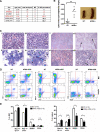The cytoplasmic NPM mutant induces myeloproliferation in a transgenic mouse model
- PMID: 19666870
- PMCID: PMC2858489
- DOI: 10.1182/blood-2009-03-208587
The cytoplasmic NPM mutant induces myeloproliferation in a transgenic mouse model
Abstract
Although NPM1 gene mutations leading to aberrant cytoplasmic expression of nucleophosmin (NPMc(+)) are the most frequent genetic lesions in acute myeloid leukemia, there is yet no experimental model demonstrating their oncogenicity in vivo. We report the generation and characterization of a transgenic mouse model expressing the most frequent human NPMc(+) mutation driven by the myeloid-specific human MRP8 promoter (hMRP8-NPMc(+)). In parallel, we generated a similar wild-type NPM trans-genic model (hMRP8-NPM). Interestingly, hMRP8-NPMc(+) transgenic mice developed myeloproliferation in bone marrow and spleen, whereas nontransgenic littermates and hMRP8-NPM transgenic mice remained disease free. These findings provide the first in vivo evidence indicating that NPMc(+) confers a proliferative advantage in the myeloid lineage. No spontaneous acute myeloid leukemia was found in hMPR8-NPMc(+) or hMRP8-NPM mice. This model will also aid in the development of therapeutic regimens that specifically target NPMc(+).
Figures


 represents an erythroblast;
represents an erythroblast;  , granulocytes. (iii) NPMc+ BM (hematoxylin and eosin, original magnification, ×1000). (iv) NPMc+ BM cytospin (original magnification, ×1000).
, granulocytes. (iii) NPMc+ BM (hematoxylin and eosin, original magnification, ×1000). (iv) NPMc+ BM cytospin (original magnification, ×1000).  represent granulocytes. (v) NT spleen (hematoxylin and eosin, original magnification, ×40). (vi) NT spleen (hematoxylin and eosin, original magnification, ×400). (vii) NPMc+ spleen (hematoxylin and eosin, original magnification, ×40).
represent granulocytes. (v) NT spleen (hematoxylin and eosin, original magnification, ×40). (vi) NT spleen (hematoxylin and eosin, original magnification, ×400). (vii) NPMc+ spleen (hematoxylin and eosin, original magnification, ×40).  represents areas of expanded red pulp with extramedullary hematopoiesis. (viii) NPMc+ spleen (hematoxylin and eosin, original magnification, ×400).
represents areas of expanded red pulp with extramedullary hematopoiesis. (viii) NPMc+ spleen (hematoxylin and eosin, original magnification, ×400).  represents extramedullary hematopoiesis. (D) Flow cytometric analysis of single-cell suspensions of BM and spleen from representative NT and NPMc+ transgenic mice demonstrates an increase in granulocytic/monocytic (Mac-1+;Gr-1+) and mature myeloid (Mac-1+;cKit−) cells with a corresponding decrease in the amount of B (B220+) and T (CD3+) lymphoid cell populations. (E) Quantification of granulocytic/monocytic (Mac-1+;Gr-1+), mature myeloid (Mac-1+/cKit+), B cells (B2200+), and T cells (CD3+) in BM and spleen of age-matched NT and NPMc+ transgenic mice analyzed as in panel D (mean ± SEM; NT, n = 6; NPMc+ 28, n = 6). *P < .05. **P < .01. ***P < .001. n.s. indicates not statistically significant.
represents extramedullary hematopoiesis. (D) Flow cytometric analysis of single-cell suspensions of BM and spleen from representative NT and NPMc+ transgenic mice demonstrates an increase in granulocytic/monocytic (Mac-1+;Gr-1+) and mature myeloid (Mac-1+;cKit−) cells with a corresponding decrease in the amount of B (B220+) and T (CD3+) lymphoid cell populations. (E) Quantification of granulocytic/monocytic (Mac-1+;Gr-1+), mature myeloid (Mac-1+/cKit+), B cells (B2200+), and T cells (CD3+) in BM and spleen of age-matched NT and NPMc+ transgenic mice analyzed as in panel D (mean ± SEM; NT, n = 6; NPMc+ 28, n = 6). *P < .05. **P < .01. ***P < .001. n.s. indicates not statistically significant.Similar articles
-
Cytoplasmic mutated nucleophosmin is stable in primary leukemic cells and in a xenotransplant model of NPMc+ acute myeloid leukemia in SCID mice.Haematologica. 2008 May;93(5):775-9. doi: 10.3324/haematol.12225. Epub 2008 Mar 26. Haematologica. 2008. PMID: 18367491
-
Expression of the cytoplasmic NPM1 mutant (NPMc+) causes the expansion of hematopoietic cells in zebrafish.Blood. 2010 Apr 22;115(16):3329-40. doi: 10.1182/blood-2009-02-207225. Epub 2010 Mar 2. Blood. 2010. PMID: 20197555 Free PMC article.
-
Myeloid leukemia-associated nucleophosmin mutants perturb p53-dependent and independent activities of the Arf tumor suppressor protein.Cell Cycle. 2005 Nov;4(11):1593-8. doi: 10.4161/cc.4.11.2174. Epub 2005 Nov 14. Cell Cycle. 2005. PMID: 16205118
-
Role of nucleophosmin in acute myeloid leukemia.Expert Rev Anticancer Ther. 2009 Sep;9(9):1283-94. doi: 10.1586/era.09.84. Expert Rev Anticancer Ther. 2009. PMID: 19761432 Review.
-
Acute myeloid leukemia carrying cytoplasmic/mutated nucleophosmin (NPMc+ AML): biologic and clinical features.Blood. 2007 Feb 1;109(3):874-85. doi: 10.1182/blood-2006-07-012252. Epub 2006 Sep 28. Blood. 2007. PMID: 17008539 Review.
Cited by
-
Preclinical activity of a novel CRM1 inhibitor in acute myeloid leukemia.Blood. 2012 Aug 30;120(9):1765-73. doi: 10.1182/blood-2012-04-423160. Epub 2012 Jun 7. Blood. 2012. PMID: 22677130 Free PMC article.
-
Mutant NPM1 Hijacks Transcriptional Hubs to Maintain Pathogenic Gene Programs in Acute Myeloid Leukemia.Cancer Discov. 2023 Mar 1;13(3):724-745. doi: 10.1158/2159-8290.CD-22-0424. Cancer Discov. 2023. PMID: 36455589 Free PMC article.
-
Leukemia-Associated Mutations in Nucleophosmin Alter Recognition by CRM1: Molecular Basis of Aberrant Transport.PLoS One. 2015 Jun 19;10(6):e0130610. doi: 10.1371/journal.pone.0130610. eCollection 2015. PLoS One. 2015. PMID: 26091065 Free PMC article.
-
NPM 1 Mutations in AML-The Landscape in 2023.Cancers (Basel). 2023 Feb 12;15(4):1177. doi: 10.3390/cancers15041177. Cancers (Basel). 2023. PMID: 36831522 Free PMC article. Review.
-
Targeting levels or oligomerization of nucleophosmin 1 induces differentiation and loss of survival of human AML cells with mutant NPM1.Blood. 2011 Sep 15;118(11):3096-106. doi: 10.1182/blood-2010-09-309674. Epub 2011 Jun 30. Blood. 2011. PMID: 21719597 Free PMC article.
References
-
- Grisendi S, Mecucci C, Falini B, Pandolfi PP. Nucleophosmin and cancer. Nat Rev Cancer. 2006;6(7):493–505. - PubMed
-
- Falini B, Mecucci C, Tiacci E, et al. Cytoplasmic nucleophosmin in acute myelogenous leukemia with a normal karyotype. N Engl J Med. 2005;352(3):254–266. - PubMed
-
- Falini B, Bolli N, Shan J, et al. Both carboxy-terminus NES motif and mutated tryptophan(s) are crucial for aberrant nuclear export of nucleophosmin leukemic mutants in NPMc+ AML. Blood. 2006;107(11):4514–4523. - PubMed
-
- Falini B, Nicoletti I, Martelli MF, Mecucci C. Acute myeloid leukemia carrying cytoplasmic/mutated nucleophosmin (NPMc+ AML): biologic and clinical features. Blood. 2007;109(3):874–885. - PubMed
-
- Haferlach C, Mecucci C, Schnittger S, et al. AML with mutated NPM1 carrying a normal or aberrant karyotype show overlapping biological, pathological, immunophenotypic, and prognostic features. Blood. 2009;114(14):3024–3032. - PubMed
Publication types
MeSH terms
Substances
Grants and funding
LinkOut - more resources
Full Text Sources
Other Literature Sources
Medical
Molecular Biology Databases

